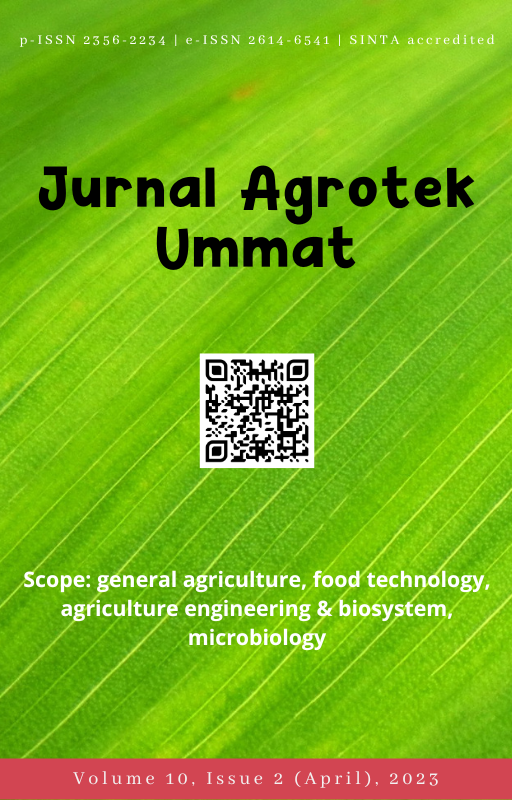Identification of weed dominance and diversity in organic and conventional paddy field (Oryza sativa L.) cultivation
DOI:
https://doi.org/10.31764/jau.v10i2.14129Keywords:
diversity index, organic rice field, quadrant methodAbstract
The presence of weeds in paddy rice crops results in a decrease in yields. Appropriate weed control methods are needed as an effort to reduce potential production losses. The first step to find out the right way to control weeds is by identifying the dominance and diversity of existing weeds. This study aims was to determine the dominance and diversity of weeds in organic and conventional paddy fields. This research was conducted in organic and conventional paddy fields of Lampung State Polytechnic, Lampung Province from October to December 2022. Weeds were observed on the 0.5 m2 quadrant method with 10 replications. The data were analyszed to find the Summed Dominance Ratio (SDR) value to determine the dominant weed and the Shannon - Wiener index (H') value to determine weed diversity. The identification results showed there were 11 weed species in organic land and 7 weed species in conventional land. Broadleaf weeds were the most dominant weeds in both land areas, namely Monochoria vaginalis in organic rice fields and Spenochlea zeylanica in conventional rice fields. The results of the weed diversity index analysis showed that in both land areas fall into the category of moderate diversitywith the value of 2.31 in organic rice fields and 1.93 in conventional rice fields.
References
Benaragama, D., Leeson, J. L., & Shirtliffe, S. J. (2019). Understanding the long-term weed community dynamics in organic and conventional crop rotations using the principal response curve method. Weed Science, 67(2), 195–204.
Hidayat, S., & Rachmadiyanto, A. N. (2017). Utilization of alang-alang (Imperata cylindrica (L.) Raeusch.) as traditional medicine in Indonesian archipelago. Proceedings The SATREPS Conference, 1(1), 82–89.
Hutapea, C., Syofian, M., & Sudirman, A. (2015). Pengaruh berbagai jenis pupuk organik terhadap spesies gulma invasif. Jurnal Agro Industri Perkebunan, 21–33.
Imaniasita, V., Liana, T., & Pamungkas, D. S. (2020). Identifikasi Keragaman dan Dominansi Gulma pada Lahan Pertanaman Kedelai. Agrotechnology Research Journal, 4(1), 11–16.
MacLaren, C., Storkey, J., Menegat, A., Metcalfe, H., & Dehnen-Schmutz, K. (2020). An ecological future for weed science to sustain crop production and the environment. A review. Agronomy for Sustainable Development, 40, 1–29.
Nugraha, A. S., Mutakin, J., & Sativa, N. (2021). Pengaruh Berbagai Pupuk Kandang Dan Jarak Tanam Terhadap Keanekaragaman, Dominansi Dan Laju Tumbuh Gulma Pada Tanaman Bawang Merah. Jagros: Jurnal Agroteknologi Dan Sains (Journal of Agrotechnology Science), 5(2), 353–362.
Perdana, E. O., & Syam, Z. (2013). Analisis Vegetasi Gulma Pada Tanaman Buah Naga Merah (Hylocereus polyrhizus, L.) di Kecamatan Batang Anai, Kabupaten Padang Pariaman, Sumatera Barat. Jurnal Biologi UNAND, 2(4).
Rachma, N., & Umam, A. S. (2021). Pertanian organik sebagai solusi pertanian berkelanjutan di Era New Normal. Jurnal Pembelajaran Pemberdayaan Masyarakat (JP2M), 1(4), 328–338.
Rahmadi, R., & Rochman, F. (2020). Efikasi Herbisida Isopropilamina Glifosat 480 SL Pada Gulma Perkebunan Karet (Hevea brasiliensis [Muell.] Arg.). JURNAL AGROREKTAN, 7(1).
Rahmadi, R., Sriyani, N., Yusnita, Pujisiswanto, H., & Hapsoro, D. (2021). Resistance status and physiological activity test of Spenochlea zeylanica and Ludwigia octovalvis in paddy field to 2,4-d and metsulfuron-methyl herbicides. Biodiversitas, 22(5), 2829–2838. https://doi.org/10.13057/biodiv/d220547
Rusdi, R., Saleh, Z., & Ramlah, R. (2019). Keanekaragaman jenis gulma berdaun lebar pada pertanaman Jagung (Zea mays L.) di Desa Sangatta Selatan Kabupaten Kutai Timur. Jurnal Agroteknologi, 9(2), 1–6.
Shannon, C. E., & Weaver, W. (1971). The Mathematical Theory of Communication. University of Illinois Press. https://books.google.co.id/books?id=KMRUpwAACAAJ
Sureshkumar, R., Reddy, Y. A., & Ravichandran, S. (2016). Effect of weeds and their management in transplanted rice-a review. Impact Journal, 4(11), 165–180.
Tjitrosoedirdjo, S., Utomo, I. H., & Wiroatmodjo, J. (1984). Pengelolaan gulma di perkebunan. PT. Gramedia. Jakarta, 225.
Widaryanto, E., Saitama, A., & Zaini, A. H. (2021). Teknologi Pengendalian Gulma. Universitas Brawijaya Press.
Zarwazi, L. M., Chozin, M. A., & Guntoro, D. (2016). Potensi gangguan gulma pada tiga sistem budidaya padi sawah. Jurnal Agronomi Indonesia (Indonesian Journal of Agronomy), 44(2), 147–153.
Downloads
Published
Issue
Section
License
Authors who publish articles in Jurnal Agrotek Ummatagree to the following terms:- Authors retain copyright of the article and grant the journal right of first publication with the work simultaneously licensed under a CC-BY-SA or The Creative Commons Attribution–ShareAlike License.
- Authors are able to enter into separate, additional contractual arrangements for the non-exclusive distribution of the journal's published version of the work (e.g., post it to an institutional repository or publish it in a book), with an acknowledgment of its initial publication in this journal.
- Authors are permitted and encouraged to post their work online (e.g., in institutional repositories or on their website) prior to and during the submission process, as it can lead to productive exchanges, as well as earlier and greater citation of published work (See The Effect of Open Access).

